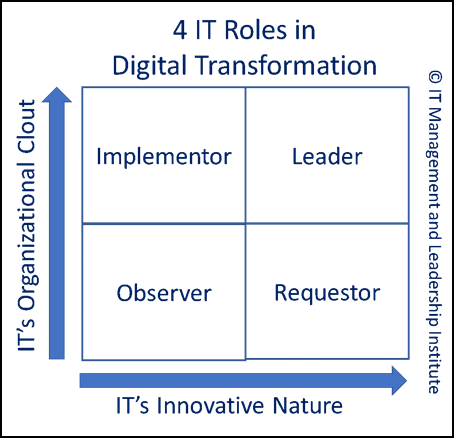Digital Transformation (DX), by its very name, refers to how digital technologies can be used to generate new revenue streams, create new markets, increase internal organizational productivity and more. While the use of established and leading-edge technologies is, of course, paramount to DX related endeavors, soft skills, such as interpersonal communication, change management, influence and others, are the unsung heroes of successful DX implementations. Unless you’re using bleeding-edge technologies, the technology is often the easy part.
From a CIO perspective, the biggest non-technical DX challenges are:
- How IT is positioned within your company or organization to drive DX
- CIO's ability to drive business vision, not only technical vision
- You team’s ability to be viewed as equal business partners with their non-IT counterparts
How IT is positioned to drive DX
IT’s ability to be the driving force behind the organization’s DX endeavors is based on two key factors:
- IT’s Organizational Clout
- IT’s innovative business and technical nature
IT’s organizational clout refers to how IT is viewed with regard to its competency, its importance in driving profitability, the c-suites' philosophy on technology, and other related factors. The more IT is respected and trusted by their business counterparts, the easier it will be for the CIO and her senior team to lead the organization’s DX endeavors.
IT’s innovative nature refers to its willingness and ability to innovate on behalf of the company, not just IT. This ability requires an innovative culture, business/industry knowledge, an understanding of business and technical trends, technical ability, and the time and tools to be innovative.

Figure 1
The horizontal axis in Figure 1, “IT’s Innovative Nature”, is the willingness and ability to innovate within IT and on behalf of the company as a whole.
The vertical axis in Figure 1, “IT’s Organizational Clout”, is the amount of influence, respect and confidence the organization has toward IT. In other words, the organization’s willingness to listen to and accept IT’s advice and recommendations.
While IT’s technical ability to provide a quality computing environment is of the utmost importance, organizational clout and an innovative nature are primarily driven by soft skills, such as leadership ability and interpersonal communication, and emotional intelligence.
Furthermore, these soft skills must exist throughout the IT organization, not just within its CIO and senior IT leadership staff.
CIO's ability to drive business vision, not only technical vision
As CIOs, we know that we cannot just be the “head techie”, we must be strong business executives that have the ability to run a technical organization. This idea has been stated and discussed in IT circles for years. With DX, it’s not simply a career-enhancing concept, it’s a fundamental requirement of having a seat at the DX strategy table.
As shown in Figure 1, if IT, and/or you as the CIO, have low organization clout, you will either be an “Observer” or a “Requestor”. As an Observer, IT is not participating meaningfully in the organization’s DX-related activities. As a Requestor, IT has great innovative ideas but it lacks the internal clout to push its agenda forward. Therefore, IT must sell it to those with formal or informal authority for their consent and support.
As also shown in Figure 1, if IT has a low innovative nature, IT is either an uninvolved “Observer”, or an “Implementor” building/executing the DX strategy defined by others, without a seat at the DX strategy table.
To move yourself and your team into the “Leader” quadrant, the following business skills and knowledge are required:
- Knowledge
- Your company’s business strengths, weaknesses and views on technological innovation
- Business and technical trends within your industry and related industries
- IT’s current software architecture, flexibility and technical debt
- Skills
- Personal and organizational emotional intelligence
- Strategic thinking and planning
- Interpersonal communication, including storytelling, questioning, active listening, writing and presentation skills
- Business skills including influence, negotiation, change management and conflict resolution
This combination of knowledge and skills, perfectly positions you in a thought leadership role for DX related initiatives.
Your team’s ability to be viewed as equal business partners
The knowledge and skills listed above for the CIO are also critical success factors for other IT executives and managers in your organization, especially those who have daily contact with business counterparts. Without their leadership, IT cannot gain the organizational credibility needed to earn and hold a seat at the DX strategy table.
While many senior IT executives possess these skills, through experience, training and natural ability, there are many that do not. Therefore, providing leadership, interpersonal communication and other soft skills training to those on your team not only helps build your management bench strength, it properly positions you and your team for DX strategic leadership.
When you stop and think about it, the fact is that IT has been doing DX-like work for over 30 years. The current DX megatrend gives IT an incredible opportunity to truly take a permanent seat at the strategy table. To keep those seats, CIOs and their IT leaders must be business savvy executives first and technologists a second.

Written by Eric Bloom
Eric Bloom is the Executive Director of the IT Management and Leadership Institute, a leading provider of IT leadership, interpersonal communication, and business skills training and certification. Eric is also an Amazon #1 bestselling author, former nationally syndicated columnist, Certified Professional Speaker (CSP), TEDx Talk speaker, trainer, CIO.com contributor, past President of National Speakers Association (NSA) New England, and an IDC Research Advisor. His books include the Amazon #1 bestseller “Productivity Driven Success: Hidden Secrets of Organizational Efficiency”, Office Influence: Get what you want, from the mailroom to the boardroom, and "The CIO’s Guide to Staff Needs, Growth, and Productivity."



